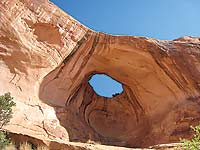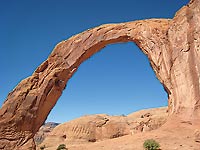Welcome to our unique corner of the world - to our spectacular slice of geology and our sensational collection of arches. No matter how long I live here, the novelty of this extraordinary landscape never seems to wear off. Consequently every hike I take continues to be a fresh exploration. So join me now, both locals and visitors, on a 1.5 mile walk as I revisit two uniquely different arches – Bowtie and Corona – on a trail that has just enough challenges to keep it both interesting and exciting. 
From Moab it’s a quick, easy drive to the trailhead. Drive north on Highway 191, and after you cross the Colorado River Bridge, continue 1.3 more miles. Then turn left on to the Potash Road (State Road 179), and drive ten more miles to the sign for Corona and Bowtie Arch on the right side where there’s a gravel parking area with an informational kiosk.
Now all you have to do is grab your pack and start walking up Bootlegger Canyon on a popular hikers-only trail. Actual elevation gain is only 440 feet, but having said that – be forewarned - some of the drop offs can be intimidating. During the heat of summer this route offers minimal shade so a crack-of-dawn start is a wise thing to do. The cooler temperatures in the spring or fall make for more comfortable hiking conditions, but that’s when this trail is most crowded. If you’re seeking more solitude, winter is a better choice (although I don’t recommend it when there’s snow or ice on the ground).
A late cold snap during early April has put the big bloom of wildflowers on hold. The big exceptions are: the bright yellow, daisy-like naked stem bahia, the palest of blue tomentose amsonia, and the elegance of those lovely ladies of the desert – the pure white evening primrose.
Initially there’s no easy-going warm-up. Instead this trail instantly starts a steep climb. With each step upward I stare farther down the length of the Colorado River as a pair of vocal Canada geese fly down stream. Upon reaching the trail register you’ll immediately be crossing the railroad track. This spur, which was built in 1964, connects the potash plant at the end of Potash Road to the main line at Crescent Jct. on I-70. Just below Corona Arch, a several-times-a-week train enters a one-mile long tunnel and emerges to the light of day above Highway 191.
After crossing the tracks, the river views disappear, and an old, eroding road gradually travels through a gap in the rim. The uphill workout continues. The saving grace, however, is that several level areas during the ascent offer you a chance to catch your breath. I always take this opportunity to look around at the gigantic mounds of sandstone that surround me from every direction.
Now we’re following the cairns (piles of rock) toward the base of a cliff, where the challenges are directly ahead as gradually the slickrock tilts up on a severe slant. At this point, if you’re feeling nervous a long cable to hang on to is there for an extra measure of security.
Shortly after that, I am grateful for the aid of another cable to pull myself up the super steep Moki steps that have been chipped out of the slickrock. When you reach the top of that staircase - ah ha – here’s your first glimpse of Corona Arch. But don’t start celebrating yet. There’s one more challenge left – the metal ladder. This is so easy for some, but climbing ladders is not everyone’s favorite activity. At least, it is short, and once on top you’re walking on the final bench of slickrock where the cairns point out the most direct route to those two distinctive arches. 
I always stop at Bowtie first to observe the unusual structure of a pothole arch, which is formed when water collects in a depression in the overhanging slickrock. As erosion, both chemically and mechanically, erodes the sandstone, eventually the bottom falls out, and Bowtie looks like someone punched a hole in the roof resulting in a lopsided skylight.
What attracts me the most, especially on an overly warm day, are the seeps of water below this arch where a hanging garden is filled with tiny, light pink cave primroses. In their moist environment they cling tenaciously to every tidbit of available soil within the cracks of the wall. This drip irrigation continues to flow down the slickrock to a depression filled with life-giving dirt that nourishes a miniature garden of grasses, junipers and a small cottonwood tree – Something you don’t expect in this huge expanse of solid slickrock.
Corona Arch is close by and no matter how many times I see this stupendous structure, its immensity and shape never cease to amaze me. With one arm jutting out of a cliff face, it has been referred to as a buttress arch. Because of its resemblance to Rainbow Bridge on Lake Powell, it is also known as Little Rainbow Bridge Arch. With a 140 X 105 foot opening, however, this portal is anything but little. Within these immense dimensions a small fixed-winged plane has flown through its gaping opening, an aerial feat that is now illegal.
To build a buttress-looking arch, first start with a big block of sandstone. Then wait while the water seeps into the cracks and collects at the weaker points. Gradually a chemical reaction between the water and the rock tear down the natural silica cement that holds everything together. As time marches on, rock particles start peeling off. After while the relentless cycle of freezing and thawing creates a pressure so powerful it acts like a wrecking ball that knocks out larger chunks until an opening appears. Gradually it enlarges and then, a million years later, it’s done – the full-scale showcase of Corona Arch.
Sitting under Corona’s massive formation, it is entertaining to do some people watching. All ages and abilities are represented: kids with energy to spare as they race around testing their rock-balancing skills, families enjoying the antics of their children, couples, senior citizens, serious hikers and even joggers. Some of these determined souls seemed surprised they could possibly make it this far.
People from all over the country, all parts of the world travel to southeast Utah to admire the handiwork of our bizarre geological creations. As I watch their reactions, it is obvious they are blown away by the powerful poses of these two arches as well as the rest of our dazzling landscape.
|



